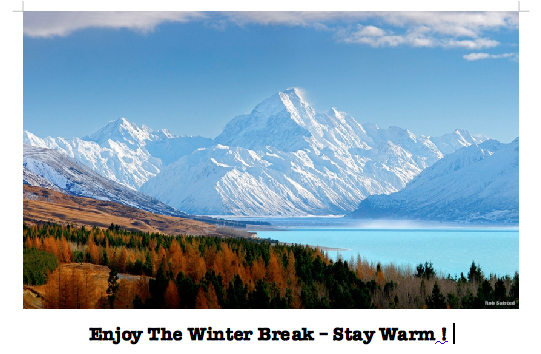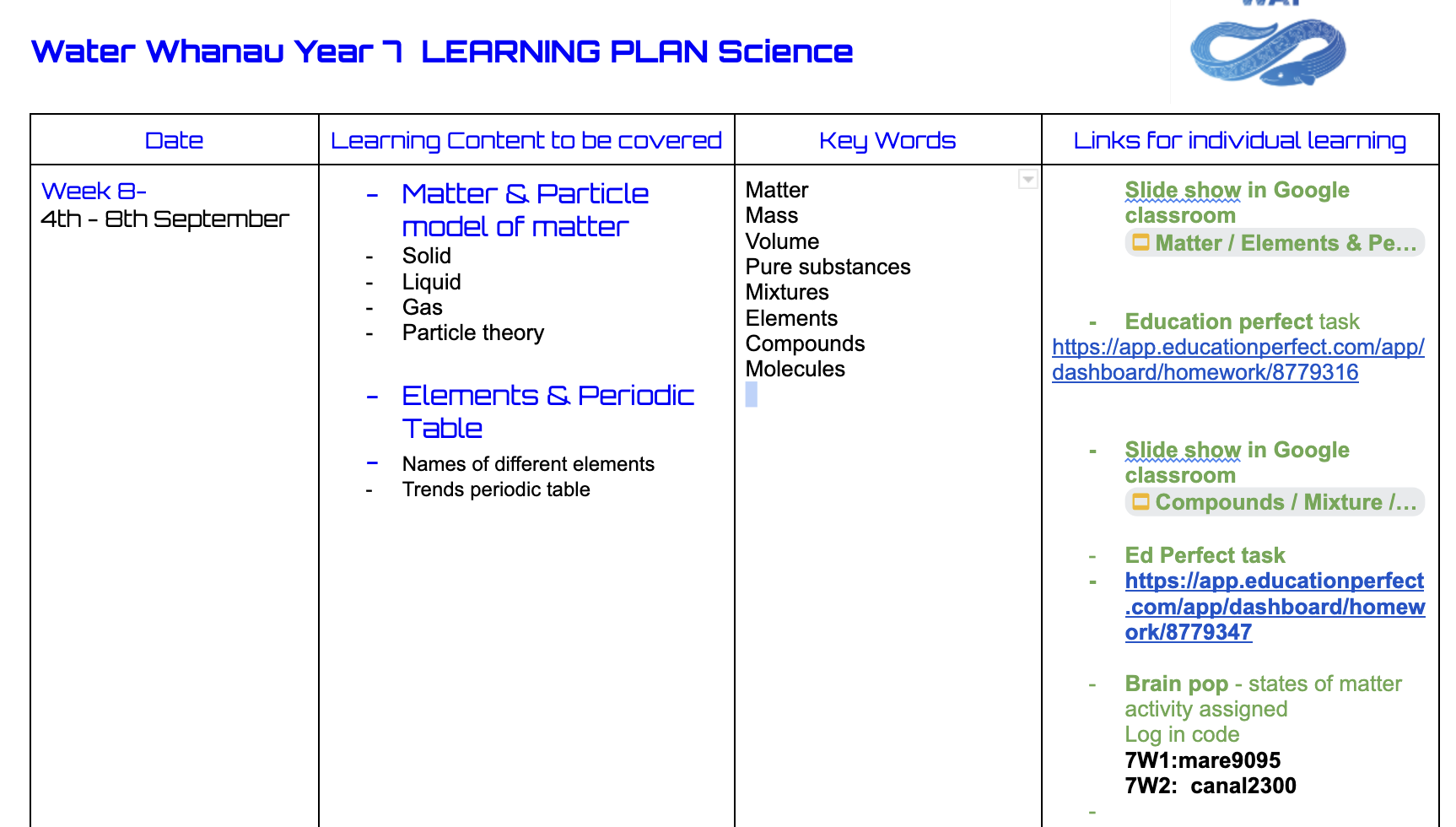7W2 Science
Section outline
-

EXPLORE / TŪHURA learning intentions:
- We are EXPLORING the Science lab, the equipment used and the rules that apply to working here
- We are EXPLORING what makes us unique and how we are different from our classmates - variation
- We are EXPLORING the environment in Tane bush and the organisms that live there
- We are EXPLORING the classification of organisms and how we fit into this big picture
Learning Intentions : We are learning to (WALT)...
- List the safety rules for working in a science laboratory
- Identify safety hazard (HAZCHEM) symbols
- Identify common laboratory equipment
- Draw laboratory equipment in a scientific manner
- Learn about carrying out fair tests
- Learn about what makes us unique - variation within our class and whanau
- Learn about the classification system and how we fit into this
- Learn about what we are made up of and how this helps us function
- Describe different environments and investigate what lives in them
- Success Criteria: I can/have...
- Correctly identify and draw the different apparatus found in a science laboratory
- Drawn up a list of safety rules for the science laboratory and draw a poster to go up in the room
- Describe and identify the different hazards from the HAZCHEM symbols
- Explain how to work safely in the science laboratory
- Tabulate the differences between the different types of organisms found in the Vertebrate Class
- Label a typical diagram of a cell
- Describe what variation is and why it is important
- Investigate the different environments in the school and discuss what organisms live in these environments
Activities:
- Google classroom tasks
- Videos on the topic
- Education perfect tasks
Homework:
Work not completed in class will be for HOMEWORK. Please complete all your work in the google classroom doc - do NOT make a copy and store it else where !! Please also check your e-mails and google classroom for feedback on your work.
-

EXPLORE / TŪHURA learning intentions:
- We are EXPLORING the Science lab, the equipment used and the rules that apply to working here
- We are EXPLORING what makes us unique and how we are different from our classmates - variation
- We are EXPLORING the environment in Tane bush and the organisms that live there
- We are EXPLORING the classification of organisms and how we fit into this big picture
Learning Intentions : We are learning to (WALT)...
- List the safety rules for working in a science laboratory
- Identify safety hazard (HAZCHEM) symbols
- Identify common laboratory equipment
- Draw laboratory equipment in a scientific manner
- Learn about carrying out fair tests
- Learn about what makes us unique - variation within our class and whanau
- Learn about the classification system and how we fit into this
- Learn about what we are made up of and how this helps us function
- Describe different environments and investigate what lives in them
- Success Criteria: I can/have...
- Correctly identify and draw the different apparatus found in a science laboratory
- Drawn up a list of safety rules for the science laboratory and draw a poster to go up in the room
- Describe and identify the different hazards from the HAZCHEM symbols
- Explain how to work safely in the science laboratory
- Tabulate the differences between the different types of organisms found in the Vertebrate Class
- Label a typical diagram of a cell
- Describe what variation is and why it is important
- Investigate the different environments in the school and discuss what organisms live in these environments
Activities:
- Google classroom tasks
- Videos on the topic
- Education perfect tasks
Homework:
Work not completed in class will be for HOMEWORK. Please complete all your work in the google classroom doc - do NOT make a copy and store it else where !! Please also check your e-mails and google classroom for feedback on your work.
-

EXPLORE / TŪHURA learning intentions:
- We are EXPLORING the Science lab, the equipment used and the rules that apply to working here
- We are EXPLORING what makes us unique and how we are different from our classmates - variation
- We are EXPLORING the environment in Tane bush and the organisms that live there
- We are EXPLORING the classification of organisms and how we fit into this big picture
Learning Intentions : We are learning to (WALT)...
- List the safety rules for working in a science laboratory
- Identify safety hazard (HAZCHEM) symbols
- Identify common laboratory equipment
- Draw laboratory equipment in a scientific manner
- Learn about carrying out fair tests
- Learn about what makes us unique - variation within our class and whanau
- Learn about the classification system and how we fit into this
- Learn about what we are made up of and how this helps us function
- Describe different environments and investigate what lives in them
- Success Criteria: I can/have...
- Correctly identify and draw the different apparatus found in a science laboratory
- Drawn up a list of safety rules for the science laboratory and draw a poster to go up in the room
- Describe and identify the different hazards from the HAZCHEM symbols
- Explain how to work safely in the science laboratory
- Tabulate the differences between the different types of organisms found in the Vertebrate Class
- Label a typical diagram of a cell
- Describe what variation is and why it is important
- Investigate the different environments in the school and discuss what organisms live in these environments
Activities:
- Google classroom tasks
- Videos on the topic
- Education perfect tasks
Homework:
Work not completed in class will be for HOMEWORK. Please complete all your work in the google classroom doc - do NOT make a copy and store it else where !! Please also check your e-mails and google classroom for feedback on your work.
-

EXPLORE / TŪHURA learning intentions:
- We are EXPLORING the Science lab, the equipment used and the rules that apply to working here
- We are EXPLORING what makes us unique and how we are different from our classmates - variation
- We are EXPLORING the environment in Tane bush and the organisms that live there
- We are EXPLORING the classification of organisms and how we fit into this big picture
Learning Intentions : We are learning to (WALT)...
- List the safety rules for working in a science laboratory
- Identify safety hazard (HAZCHEM) symbols
- Identify common laboratory equipment
- Draw laboratory equipment in a scientific manner
- Learn about carrying out fair tests
- Learn about what makes us unique - variation within our class and whanau
- Learn about the classification system and how we fit into this
- Learn about what we are made up of and how this helps us function
- Describe different environments and investigate what lives in them
- Success Criteria: I can/have...
- Correctly identify and draw the different apparatus found in a science laboratory
- Drawn up a list of safety rules for the science laboratory and draw a poster to go up in the room
- Describe and identify the different hazards from the HAZCHEM symbols
- Explain how to work safely in the science laboratory
- Tabulate the differences between the different types of organisms found in the Vertebrate Class
- Label a typical diagram of a cell
- Describe what variation is and why it is important
- Investigate the different environments in the school and discuss what organisms live in these environments
Activities:
- Google classroom tasks
- Videos on the topic
- Education perfect tasks
Homework:
Work not completed in class will be for HOMEWORK. Please complete all your work in the google classroom doc - do NOT make a copy and store it else where !! Please also check your e-mails and google classroom for feedback on your work.
-

EXPLORE / TŪHURA learning intentions:
- We are EXPLORING the Science lab, the equipment used and the rules that apply to working here
- We are EXPLORING what makes us unique and how we are different from our classmates - variation
- We are EXPLORING the environment in Tane bush and the organisms that live there
- We are EXPLORING the classification of organisms and how we fit into this big picture
Learning Intentions : We are learning to (WALT)...
- List the safety rules for working in a science laboratory
- Identify safety hazard (HAZCHEM) symbols
- Identify common laboratory equipment
- Draw laboratory equipment in a scientific manner
- Learn about carrying out fair tests
- Learn about what makes us unique - variation within our class and whanau
- Learn about the classification system and how we fit into this
- Learn about what we are made up of and how this helps us function
- Describe different environments and investigate what lives in them
- Success Criteria: I can/have...
- Correctly identify and draw the different apparatus found in a science laboratory
- Drawn up a list of safety rules for the science laboratory and draw a poster to go up in the room
- Describe and identify the different hazards from the HAZCHEM symbols
- Explain how to work safely in the science laboratory
- Tabulate the differences between the different types of organisms found in the Vertebrate Class
- Label a typical diagram of a cell
- Describe what variation is and why it is important
- Investigate the different environments in the school and discuss what organisms live in these environments
Activities:
- Google classroom tasks
- Videos on the topic
- Education perfect tasks
Homework:
Work not completed in class will be for HOMEWORK. Please complete all your work in the google classroom doc - do NOT make a copy and store it else where !! Please also check your e-mails and google classroom for feedback on your work.
-
FOCUS / ARONGA learning intentions:
- We are FOCUSING on understanding what we are made up of and also how and why we are different from each other

EXPLORE / TŪHURA learning intentions:
- We are EXPLORING the Science lab, the equipment used and the rules that apply to working here
- We are EXPLORING what makes us unique and how we are different from our classmates - variation
- We are EXPLORING the environment in Tane bush and the organisms that live there
- We are EXPLORING the classification of organisms and how we fit into this big picture
Learning Intentions : We are learning to (WALT)...
- List the safety rules for working in a science laboratory
- Identify safety hazard (HAZCHEM) symbols
- Identify common laboratory equipment
- Draw laboratory equipment in a scientific manner
- Learn about carrying out fair tests
- Learn about what makes us unique - variation within our class and whanau
- Learn about the classification system and how we fit into this
- Learn about what we are made up of and how this helps us function
- Describe different environments and investigate what lives in them
- Success Criteria: I can/have...
- Correctly identify and draw the different apparatus found in a science laboratory
- Drawn up a list of safety rules for the science laboratory and draw a poster to go up in the room
- Describe and identify the different hazards from the HAZCHEM symbols
- Explain how to work safely in the science laboratory
- Tabulate the differences between the different types of organisms found in the Vertebrate Class
- Label a typical diagram of a cell
- Describe what variation is and why it is important
- Investigate the different environments in the school and discuss what organisms live in these environments
Activities:
- Google classroom tasks
- Videos on the topic
- Education perfect tasks
Homework:
Work not completed in class will be for HOMEWORK. Please complete all your work in the google classroom doc - do NOT make a copy and store it else where !! Please also check your e-mails and google classroom for feedback on your work.
-

Learning Intentions : We are learning to (WALT)...
- List the safety rules for working in a science laboratory
- Identify safety hazard (HAZCHEM) symbols
- Identify common laboratory equipment
- Draw laboratory equipment in a scientific manner
- Learn about carrying out fair tests
- Learn about what makes us unique - variation within our class and whanau
- Learn about the classification system and how we fit into this
- Learn about what we are made up of and how this helps us function
- Describe different environments and investigate what lives in them
- Success Criteria: I can/have...
- Correctly identify and draw the different apparatus found in a science laboratory
- Drawn up a list of safety rules for the science laboratory and draw a poster to go up in the room
- Describe and identify the different hazards from the HAZCHEM symbols
- Explain how to work safely in the science laboratory
- Tabulate the differences between the different types of organisms found in the Vertebrate Class
- Label a typical diagram of a cell
- Describe what variation is and why it is important
- Investigate the different environments in the school and discuss what organisms live in these environments
Activities:
- Google classroom tasks
- Videos on the topic
- Education perfect tasks
Homework:
Work not completed in class will be for HOMEWORK. Please complete all your work in the google classroom doc - do NOT make a copy and store it else where !! Please also check your e-mails and google classroom for feedback on your work.
-
PLAN & DO / WHAKAMAHI learning intentions:
- We are PLANNING on drawing huge outlines of each other to show what we are made up of and also to show how we are different from each.
FOCUS / ARONGA learning intentions:
- We are FOCUSING on understanding what we are made up of and also how and why we are different from each other

Learning Intentions : We are learning to (WALT)...
- List the safety rules for working in a science laboratory
- Identify safety hazard (HAZCHEM) symbols
- Identify common laboratory equipment
- Draw laboratory equipment in a scientific manner
- Learn about carrying out fair tests
- Learn about what makes us unique - variation within our class and whanau
- Learn about the classification system and how we fit into this
- Learn about what we are made up of and how this helps us function
- Describe different environments and investigate what lives in them
- Success Criteria: I can/have...
- Correctly identify and draw the different apparatus found in a science laboratory
- Drawn up a list of safety rules for the science laboratory and draw a poster to go up in the room
- Describe and identify the different hazards from the HAZCHEM symbols
- Explain how to work safely in the science laboratory
- Tabulate the differences between the different types of organisms found in the Vertebrate Class
- Label a typical diagram of a cell
- Describe what variation is and why it is important
- Investigate the different environments in the school and discuss what organisms live in these environments
Activities:
- Google classroom tasks
- Videos on the topic
- Education perfect tasks
Homework:
Work not completed in class will be for HOMEWORK. Please complete all your work in the google classroom doc - do NOT make a copy and store it else where !! Please also check your e-mails and google classroom for feedback on your work.
-
EXPLORE / TŪHURA learning intentions:
- We are EXPLORING the structure and function of the brain by researching topics introduced in class
- We are EXPLORING the nervous system by recognising the different parts and investigating how these parts all work together to keep us alive
- We are EXPLORING methods of communicating and the basics of sound
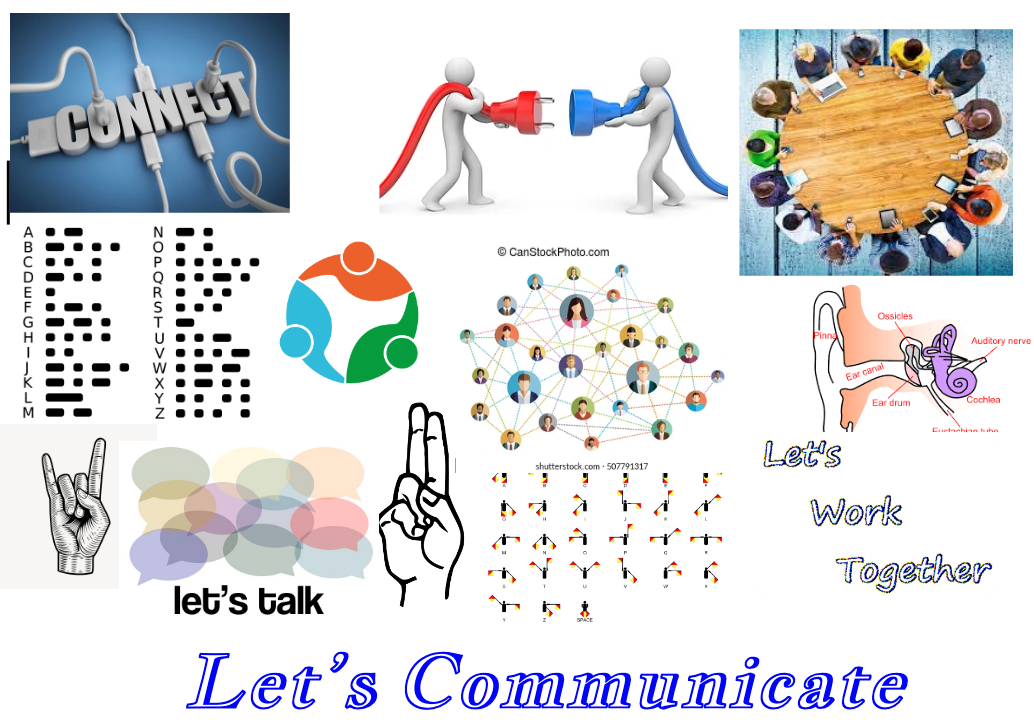
Learning Intentions : We are learning to (WALT)...
- Investigating the factors for a healthy brain
- Identify the different parts of the brain
- Identify the structure and function of a healthy brain
- Identify how our brain keeps us safe
- Describe other factors that are involved to keep our brains and bodies healthy - like a healthy diet, plenty of exercise and good sleep
- Practically investigate the different nutrient groups in food
- Success Criteria: I can/have...
- Correctly label a brain
- Describe and identify the different parts of the brain and their uses
- Explain how to have a healthy brain and body through a healthy diet exercise and sleep
- Correctly plate up a healthy plate of food
- Label a typical diagram of a nerve
- Describe why people are hungry and what we can do to help rectify this
- Investigate the different nutrients in food by performing food tests
Activities:
- Google classroom tasks
- Videos on the topic
- Education perfect tasks
Homework:
Work not completed in class will be for HOMEWORK. Please complete all your work in the google classroom doc - do NOT make a copy and store it else where !! Please also check your e-mails and google classroom for feedback on your work.
-
EXPLORE / TŪHURA learning intentions:
- We are EXPLORING the structure and function of the brain by researching topics introduced in class
- We are EXPLORING the nervous system by recognising the different parts and investigating how these parts all work together to keep us alive
- We are EXPLORING methods of communicating and the basics of sound

Learning Intentions : We are learning to (WALT)...
- Investigating the factors for a healthy brain
- Identify the different parts of the brain
- Identify the structure and function of a healthy brain
- Identify how our brain keeps us safe
- Describe other factors that are involved to keep our brains and bodies healthy - like a healthy diet, plenty of exercise and good sleep
- Practically investigate the different nutrient groups in food
- Success Criteria: I can/have...
- Correctly label a brain
- Describe and identify the different parts of the brain and their uses
- Explain how to have a healthy brain and body through a healthy diet exercise and sleep
- Correctly plate up a healthy plate of food
- Label a typical diagram of a nerve
- Describe why people are hungry and what we can do to help rectify this
- Investigate the different nutrients in food by performing food tests
Activities:
- Google classroom tasks
- Videos on the topic
- Education perfect tasks
Homework:
Work not completed in class will be for HOMEWORK. Please complete all your work in the google classroom doc - do NOT make a copy and store it else where !! Please also check your e-mails and google classroom for feedback on your work.
-
EXPLORE / TŪHURA learning intentions:
- We are EXPLORING the structure and function of the brain by researching topics introduced in class
- We are EXPLORING the nervous system by recognising the different parts and investigating how these parts all work together to keep us alive
- We are EXPLORING methods of communicating and the basics of sound

Learning Intentions : We are learning to (WALT)...
- Investigating the factors for a healthy brain
- Identify the different parts of the brain
- Identify the structure and function of a healthy brain
- Identify how our brain keeps us safe
- Describe other factors that are involved to keep our brains and bodies healthy - like a healthy diet, plenty of exercise and good sleep
- Practically investigate the different nutrient groups in food
- Success Criteria: I can/have...
- Correctly label a brain
- Describe and identify the different parts of the brain and their uses
- Explain how to have a healthy brain and body through a healthy diet exercise and sleep
- Correctly plate up a healthy plate of food
- Label a typical diagram of a nerve
- Describe why people are hungry and what we can do to help rectify this
- Investigate the different nutrients in food by performing food tests
Activities:
- Google classroom tasks
- Videos on the topic
- Education perfect tasks
Homework:
Work not completed in class will be for HOMEWORK. Please complete all your work in the google classroom doc - do NOT make a copy and store it else where !! Please also check your e-mails and google classroom for feedback on your work.
-
EXPLORE / TŪHURA learning intentions:
- We are EXPLORING the structure and function of the brain by researching topics introduced in class
- We are EXPLORING the nervous system by recognising the different parts and investigating how these parts all work together to keep us alive
- We are EXPLORING methods of communicating and the basics of sound

Learning Intentions : We are learning to (WALT)...
- Investigating the factors for a healthy brain
- Identify the different parts of the brain
- Identify the structure and function of a healthy brain
- Identify how our brain keeps us safe
- Describe other factors that are involved to keep our brains and bodies healthy - like a healthy diet, plenty of exercise and good sleep
- Practically investigate the different nutrient groups in food
- Success Criteria: I can/have...
- Correctly label a brain
- Describe and identify the different parts of the brain and their uses
- Explain how to have a healthy brain and body through a healthy diet exercise and sleep
- Correctly plate up a healthy plate of food
- Label a typical diagram of a nerve
- Describe why people are hungry and what we can do to help rectify this
- Investigate the different nutrients in food by performing food tests
Activities:
- Google classroom tasks
- Videos on the topic
- Education perfect tasks
Homework:
Work not completed in class will be for HOMEWORK. Please complete all your work in the google classroom doc - do NOT make a copy and store it else where !! Please also check your e-mails and google classroom for feedback on your work.
-
EXPLORE / TŪHURA learning intentions:
- We are EXPLORING the structure and function of the brain by researching topics introduced in class
- We are EXPLORING the nervous system by recognising the different parts and investigating how these parts all work together to keep us alive
- We are EXPLORING methods of communicating and the basics of sound

Learning Intentions : We are learning to (WALT)...
- Investigating the factors for a healthy brain
- Identify the different parts of the brain
- Identify the structure and function of a healthy brain
- Identify how our brain keeps us safe
- Describe other factors that are involved to keep our brains and bodies healthy - like a healthy diet, plenty of exercise and good sleep
- Practically investigate the different nutrient groups in food
- Success Criteria: I can/have...
- Correctly label a brain
- Describe and identify the different parts of the brain and their uses
- Explain how to have a healthy brain and body through a healthy diet exercise and sleep
- Correctly plate up a healthy plate of food
- Label a typical diagram of a nerve
- Describe why people are hungry and what we can do to help rectify this
- Investigate the different nutrients in food by performing food tests
Activities:
- Google classroom tasks
- Videos on the topic
- Education perfect tasks
Homework:
Work not completed in class will be for HOMEWORK. Please complete all your work in the google classroom doc - do NOT make a copy and store it else where !! Please also check your e-mails and google classroom for feedback on your work.
-
EXPLORE / TŪHURA learning intentions:
- We are EXPLORING the structure and function of the brain by researching topics introduced in class
- We are EXPLORING the nervous system by recognising the different parts and investigating how these parts all work together to keep us alive
- We are EXPLORING methods of communicating and the basics of sound

Learning Intentions : We are learning to (WALT)...
- Investigating the factors for a healthy brain
- Identify the different parts of the brain
- Identify the structure and function of a healthy brain
- Identify how our brain keeps us safe
- Describe other factors that are involved to keep our brains and bodies healthy - like a healthy diet, plenty of exercise and good sleep
- Practically investigate the different nutrient groups in food
- Success Criteria: I can/have...
- Correctly label a brain
- Describe and identify the different parts of the brain and their uses
- Explain how to have a healthy brain and body through a healthy diet exercise and sleep
- Correctly plate up a healthy plate of food
- Label a typical diagram of a nerve
- Describe why people are hungry and what we can do to help rectify this
- Investigate the different nutrients in food by performing food tests
Activities:
- Google classroom tasks
- Videos on the topic
- Education perfect tasks
Homework:
Work not completed in class will be for HOMEWORK. Please complete all your work in the google classroom doc - do NOT make a copy and store it else where !! Please also check your e-mails and google classroom for feedback on your work.
-
PLAN & DO / WHAKAMAHI learning intentions:
- We are PLANNING on designing a healthy plate of food so that we can advise the rest of the Water Whanau maintain a healthy body and brain

Learning Intentions : We are learning to (WALT)...
- Investigating the factors for a healthy brain
- Identify the different parts of the brain
- Identify the structure and function of a healthy brain
- Identify how our brain keeps us safe
- Describe other factors that are involved to keep our brains and bodies healthy - like a healthy diet, plenty of exercise and good sleep
- Practically investigate the different nutrient groups in food
- Plan a Healthy meal taking into account the different nutrients needed for growth of a teenager
- Successfully read a food label
- Successfully plot the data found on a food label
- Success Criteria: I can/have...
- Correctly label a brain
- Describe and identify the different parts of the brain and their uses
- Explain how to have a healthy brain and body through a healthy diet exercise and sleep
- Correctly plate up a healthy plate of food
- Label a typical diagram of a nerve
- Describe why people are hungry and what we can do to help rectify this
- Investigate the different nutrients in food by performing food tests
- Plan a healthy meal
- Read a food label
- Plot a graph of the data found in a food label
Activities:
- Google classroom tasks
- Videos on the topic
- Education perfect tasks
Homework:
Work not completed in class will be for HOMEWORK. Please complete all your work in the google classroom doc - do NOT make a copy and store it else where !! Please also check your e-mails and google classroom for feedback on your work.
-
PLAN & DO / WHAKAMAHI learning intentions:
- We are PLANNING on designing a healthy plate of food so that we can advise the rest of the Water Whanau maintain a healthy body and brain

Learning Intentions : We are learning to (WALT)...
- Investigating the factors for a healthy brain
- Identify the different parts of the brain
- Identify the structure and function of a healthy brain
- Identify how our brain keeps us safe
- Describe other factors that are involved to keep our brains and bodies healthy - like a healthy diet, plenty of exercise and good sleep
- Practically investigate the different nutrient groups in food
- Plan a Healthy meal taking into account the different nutrients needed for growth of a teenager
- Successfully read a food label
- Successfully plot the data found on a food label
- Success Criteria: I can/have...
- Correctly label a brain
- Describe and identify the different parts of the brain and their uses
- Explain how to have a healthy brain and body through a healthy diet exercise and sleep
- Correctly plate up a healthy plate of food
- Label a typical diagram of a nerve
- Describe why people are hungry and what we can do to help rectify this
- Investigate the different nutrients in food by performing food tests
- Plan a healthy meal
- Read a food label
- Plot a graph of the data found in a food label
Activities:
- Google classroom tasks
- Videos on the topic
- Education perfect tasks
Homework:
Work not completed in class will be for HOMEWORK. Please complete all your work in the google classroom doc - do NOT make a copy and store it else where !! Please also check your e-mails and google classroom for feedback on your work.
-
FOCUS / ARONGA learning intentions:
- We are FOCUSING on a healthy brain and the factors that are needed for us to maintain a healthy well functioning brain.
- We are FOCUSING on identifying describing and using different methods of communication

Learning Intentions : We are learning to (WALT)...
- Investigating the factors for a healthy brain
- Identify the different parts of the brain
- Identify the structure and function of a healthy brain
- Identify how our brain keeps us safe
- Describe other factors that are involved to keep our brains and bodies healthy - like a healthy diet, plenty of exercise and good sleep
- Practically investigate the different nutrient groups in food
- Plan a Healthy meal taking into account the different nutrients needed for growth of a teenager
- Successfully read a food label
- Successfully plot the data found on a food label
- Success Criteria: I can/have...
- Correctly label a brain
- Describe and identify the different parts of the brain and their uses
- Explain how to have a healthy brain and body through a healthy diet exercise and sleep
- Correctly plate up a healthy plate of food
- Label a typical diagram of a nerve
- Describe why people are hungry and what we can do to help rectify this
- Investigate the different nutrients in food by performing food tests
- Plan a healthy meal
- Read a food label
- Plot a graph of the data found in a food label
Activities:
- Google classroom tasks
- Videos on the topic
- Education perfect tasks
Homework:
Work not completed in class will be for HOMEWORK. Please complete all your work in the google classroom doc - do NOT make a copy and store it else where !! Please also check your e-mails and google classroom for feedback on your work.
-
EXPLORE / TŪHURA learning intentions:
- We are EXPLORING unique legends of NZ by observing and researching and at the NZ Natural World and its organisms
- We are EXPLORING the Material world strand, by looking at NZ scientists that played a role in atomic science
- We are EXPLORING The Physical World Strand by investigating legend sport stars and the physics behind the different sports
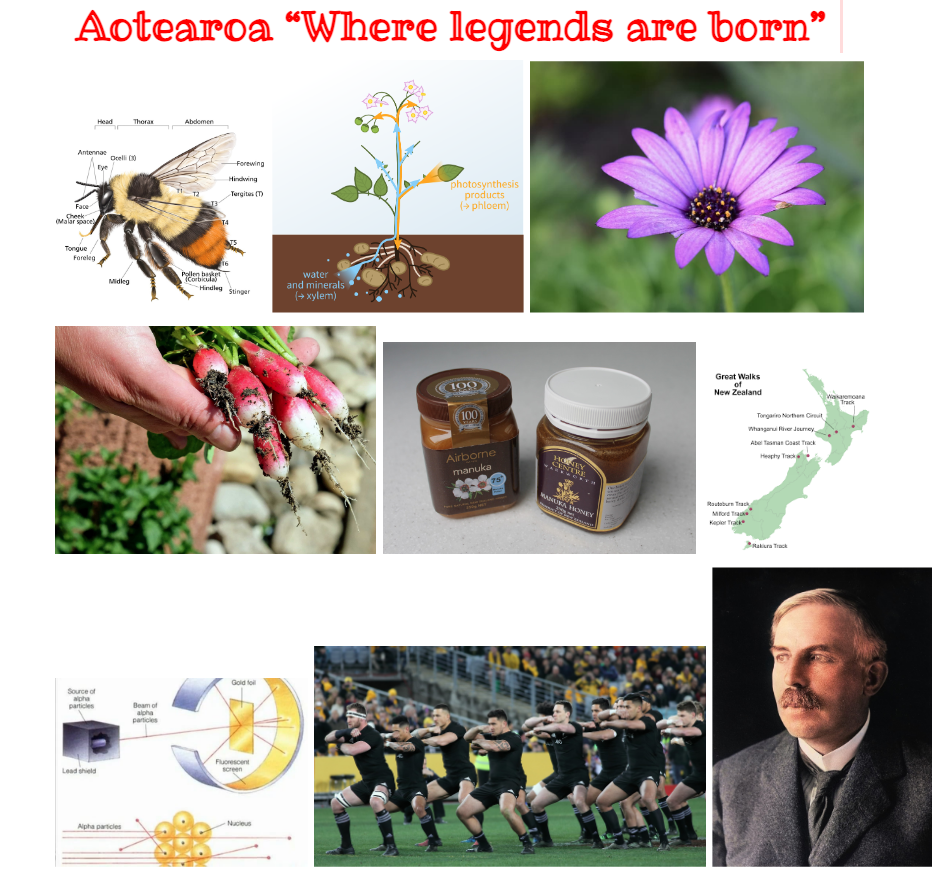
Learning Intentions : We are learning to (WALT)...
- Investigate the different parts of a plant
- Understand the different functions of the plant organs and how our food is mostly modified plant organs
- Understand how a seed germinates and grows into a plant that we can eat
- Understand why pollinating agents like bees are important
- Investigate different types of pollinating agents
- Research why Manuka honey is particularly important to New Zealand and a Legend in NZ
- Success Criteria: I can/have...
- Draw and label the different parts of a plant
- Explain how modified plant organs are food
- Germinate some seeds and plant these in our veggie garden
- Label a diagram of a bee and explain why bees are important pollinating agents
- Describe how flowers reproduce and the importance of pollinating agents
- Can explain why Manuka honey is an important income source in NZ and why it is one of our legends
Activities:
- Google classroom tasks
- Videos on the topic
- Education perfect tasks
- Germinate seeds
- Plant these seeds out in our veggie garden
Homework:
Work not completed in class will be for HOMEWORK. Please complete all your work in the google classroom doc - do NOT make a copy and store it else where !! Please also check your e-mails and google classroom for feedback on your work.
-
EXPLORE / TŪHURA learning intentions:
- We are EXPLORING unique legends of NZ by observing and researching and at the NZ Natural World and its organisms
- We are EXPLORING the Material world strand, by looking at NZ scientists that played a role in atomic science
- We are EXPLORING The Physical World Strand by investigating legend sport stars and the physics behind the different sports

Learning Intentions : We are learning to (WALT)...
- Investigate the different parts of a plant
- Understand the different functions of the plant organs and how our food is mostly modified plant organs
- Understand how a seed germinates and grows into a plant that we can eat
- Understand why pollinating agents like bees are important
- Investigate different types of pollinating agents
- Research why Manuka honey is particularly important to New Zealand and a Legend in NZ
- Success Criteria: I can/have...
- Draw and label the different parts of a plant
- Explain how modified plant organs are food
- Germinate some seeds and plant these in our veggie garden
- Label a diagram of a bee and explain why bees are important pollinating agents
- Describe how flowers reproduce and the importance of pollinating agents
- Can explain why Manuka honey is an important income source in NZ and why it is one of our legends
Activities:
- Google classroom tasks
- Videos on the topic
- Education perfect tasks
- Germinate seeds
- Plant these seeds out in our veggie garden
Homework:
Work not completed in class will be for HOMEWORK. Please complete all your work in the google classroom doc - do NOT make a copy and store it else where !! Please also check your e-mails and google classroom for feedback on your work.
-
EXPLORE / TŪHURA learning intentions:
- We are EXPLORING unique legends of NZ by observing and researching and at the NZ Natural World and its organisms
- We are EXPLORING the Material world strand, by looking at NZ scientists that played a role in atomic science
- We are EXPLORING The Physical World Strand by investigating legend sport stars and the physics behind the different sports

Learning Intentions : We are learning to (WALT)...
- Investigate the different parts of a plant
- Understand the different functions of the plant organs and how our food is mostly modified plant organs
- Understand how a seed germinates and grows into a plant that we can eat
- Understand why pollinating agents like bees are important
- Investigate different types of pollinating agents
- Research why Manuka honey is particularly important to New Zealand and a Legend in NZ
- Success Criteria: I can/have...
- Draw and label the different parts of a plant
- Explain how modified plant organs are food
- Germinate some seeds and plant these in our veggie garden
- Label a diagram of a bee and explain why bees are important pollinating agents
- Describe how flowers reproduce and the importance of pollinating agents
- Can explain why Manuka honey is an important income source in NZ and why it is one of our legends
Activities:
- Google classroom tasks
- Videos on the topic
- Education perfect tasks
- Germinate seeds
- Plant these seeds out in our veggie garden
Homework:
Work not completed in class will be for HOMEWORK. Please complete all your work in the google classroom doc - do NOT make a copy and store it else where !! Please also check your e-mails and google classroom for feedback on your work.
-
EXPLORE / TŪHURA learning intentions:
- We are EXPLORING unique legends of NZ by observing and researching and at the NZ Natural World and its organisms
- We are EXPLORING the Material world strand, by looking at NZ scientists that played a role in atomic science
- We are EXPLORING The Physical World Strand by investigating legend sport stars and the physics behind the different sports

Learning Intentions: We are learning to (WALT).
- Start investigating insects, specifically bees
- Look at the difference between insects spiders and crustaceans (classification)
- Investigate these differences by doing bit of research
- Safety around electricity
- Use an Identification key to identify various unknown insects
Success Criteria: I can/have...
- Explain what the difference is between insects arachnids and crustaceans
- Perform basic research from a given site
Activities:
- Watch u tube clips on what makes an insect an insect
- Literacy activity on bees
- Practical activity- plant a seed for a future science
Homework:
ALL WORK NOT COMPLETED IN CLASS IS HOMEWORK !!
-
EXPLORE / TŪHURA learning intentions:
- We are EXPLORING unique legends of NZ by observing and researching and at the NZ Natural World and its organisms
- We are EXPLORING the Material world strand, by looking at NZ scientists that played a role in atomic science
- We are EXPLORING The Physical World Strand by investigating legend sport stars and the physics behind the different sports

Learning Intentions: We are learning to (WALT).
- Start investigating insects, specifically bees
- Look at the difference between insects spiders and crustaceans (classification)
- Investigate these differences by doing bit of research
- Safety around electricity
- Use an Identification key to identify various unknown insects
Success Criteria: I can/have...
- Explain what the difference is between insects arachnids and crustaceans
- Perform basic research from a given site
Activities:
- Watch u tube clips on what makes an insect an insect
- Literacy activity on bees
- Practical activity- plant a seed for a future science
Homework:
ALL WORK NOT COMPLETED IN CLASS IS HOMEWORK !!
-
EXPLORE / TŪHURA learning intentions:
- We are EXPLORING unique legends of NZ by observing and researching and at the NZ Natural World and its organisms
- We are EXPLORING the Material world strand, by looking at NZ scientists that played a role in atomic science
- We are EXPLORING The Physical World Strand by investigating legend sport stars and the physics behind the different sports

Learning Intentions: We are learning to (WALT).
- Start investigating insects, specifically bees
- Look at the difference between insects spiders and crustaceans (classification)
- Investigate these differences by doing bit of research
- Safety around a hive
- Use an Identification key to identify various unknown insects
Success Criteria: I can/have...
- Explain what the difference is between insects arachnids and crustaceans
- Perform basic research on the manuka honey bee from a given site
Activities:
- Watch u tube clips on what makes an insect an insect
- Literacy activity on bees
- Practical activity- plant a seed for a future science
Homework:
ALL WORK NOT COMPLETED IN CLASS IS HOMEWORK !!
-

Learning Intentions: We are learning to (WALT).
- Start investigating insects, specifically bees
- Look at the difference between insects spiders and crustaceans (classification)
- Investigate these differences by doing bit of research
- Safety around electricity
- Use an Identification key to identify various unknown insects
- Start to look at our Chemistry Legends
- Investigate the perodic table and the first 20 elements
Success Criteria: I can/have...
- Explain what the difference is between insects arachnids and crustaceans
- Perform basic research from a given site
- Explain what the periodic table is
- Successfully list the first 20 elements
Activities:
- Watch u tube clips on what makes an insect an insect
- Literacy activity on bees
- Practical activity- plant a seed for a future science
Homework:
ALL WORK NOT COMPLETED IN CLASS IS HOMEWORK !!
-
PLAN & DO / WHAKAMAHI learning intentions:
- We are PLANNING on Germinating seeds so that we can grow plants and flowers so that we can feed the NZ Honey Bee which produces Manuka Honey - a legend in
-
PLAN & DO / WHAKAMAHI learning intentions:
- We are PLANNING on Germinating seeds so that we can grow plants and flowers so that we can feed the NZ Honey Bee which produces Manuka Honey - a legend in NZ
FOCUS / ARONGA learning intentions:
- We are FOCUSING on developing a tour brochure that highlights the NZ legends highlighting this from a science point of view
-
EXPLORE / TŪHURA learning intentions:
- We are EXPLORING the rock cycle to understand how different parts od NZ were made
- We are EXPLORING plate tectonics to understand how and NZ is prone to volcanoes and earthquakes
- We are EXPLORING the different extreme activities that a person can do in and around Rotarua
Learning Intentions: We are learning to (WALT).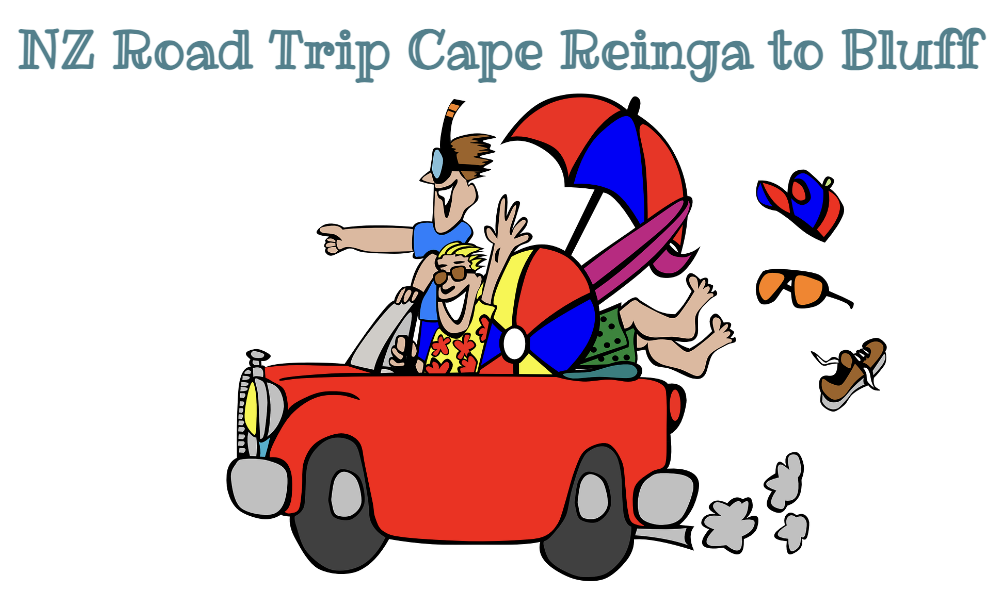
- To investigate the Geological make up of the earth
- Investigate how and why New Zealand is considered to be on the ring of fire - researching the different types of Volcano formation
- To recognise the different types of rocks and how they are made
- To understand the rock cycle and how this fits into our Volcanic New Zealand
- Investigate Plate tectonics
- To recognise how a thermal region is an important tourist hot spot
Success Criteria: I can/have...
- Describe the different layers of the earth
- Explain what the difference is between the different types of volcanoes
- To successfully explain the rock cycle and how the different rock types are formed
- Explain how and why the thermal regions in New Zealand attract tourists
- Perform basic research on plate tectonics and how this has played a role in the make up of New Zealands land mass
Activities:
- Watch u tube clips on what makes an insect an insect
- Literacy activity on bees
- Practical activities - making rock/ making fossils
Homework:
Work not completed in class will be for HOMEWORK. Please complete all your work in the google classroom doc - do NOT make a copy and store it else where !! Please also check your e-mails and google classroom for feedback on your work.
-
EXPLORE / TŪHURA learning intentions:
- We are EXPLORING the rock cycle to understand how different parts od NZ were made
- We are EXPLORING plate tectonics to understand how and NZ is prone to volcanoes and earthquakes
- We are EXPLORING the different extreme activities that a person can do in and around Rotarua
Learning Intentions: We are learning to (WALT).
- To investigate the Geological make up of New Zealand - researching the different types of Volcano formation
- To recognise the different types of rocks and how they are made
- To understand the rock cycle and how this fits into our Volcanic New Zealand
- Investigate Plate tectonics
- To recognise how a thermal region is an important tourist hot spot
Success Criteria: I can/have...
- Explain what the difference is between the different types of volcanoes
- To successfully explain the rock cycle and how the different rock types are formed
- Explain how and why the thermal regions in New Zealand attract tourists
- Perform basic research on plate tectonics and how this has played a role in the make up of New Zealands land mass
Activities:
- Watch u tube clips on what makes an insect an insect
- Literacy activity on bees
- Practical activities - making rock/ making fossils
Homework:
Work not completed in class will be for HOMEWORK. Please complete all your work in the google classroom doc - do NOT make a copy and store it else where !! Please also check your e-mails and google classroom for feedback on your work.
-
EXPLORE / TŪHURA learning intentions:
- We are EXPLORING the rock cycle to understand how different parts od NZ were made
- We are EXPLORING plate tectonics to understand how and NZ is prone to volcanoes and earthquakes
- We are EXPLORING the different extreme activities that a person can do in and around Rotarua
Learning Intentions: We are learning to (WALT).
- To investigate the Geological make up of New Zealand - researching the different types of Volcano formation
- To recognise the different types of rocks and how they are made
- To understand the rock cycle and how this fits into our Volcanic New Zealand
- Investigate Plate tectonics
- To recognise how a thermal region is an important tourist hot spot
Success Criteria: I can/have...
- Explain what the difference is between the different types of volcanoes
- To successfully explain the rock cycle and how the different rock types are formed
- Explain how and why the thermal regions in New Zealand attract tourists
- Perform basic research on plate tectonics and how this has played a role in the make up of New Zealands land mass
Activities:
- Watch u tube clips on what makes an insect an insect
- Literacy activity on bees
- Practical activities - making rock/ making fossils
Homework:
Work not completed in class will be for HOMEWORK. Please complete all your work in the google classroom doc - do NOT make a copy and store it else where !! Please also check your e-mails and google classroom for feedback on your work.
-
EXPLORE / TŪHURA learning intentions:
- We are EXPLORING the rock cycle to understand how different parts od NZ were made
- We are EXPLORING plate tectonics to understand how and NZ is prone to volcanoes and earthquakes
- We are EXPLORING the different extreme activities that a person can do in and around Rotarua
Learning Intentions: We are learning to (WALT).
- To investigate the Geological make up of New Zealand - researching the different types of Volcano formation
- To recognise the different types of rocks and how they are made
- To understand the rock cycle and how this fits into our Volcanic New Zealand
- Investigate Plate tectonics
- To recognise how a thermal region is an important tourist hot spot
Success Criteria: I can/have...
- Explain what the difference is between the different types of volcanoes
- To successfully explain the rock cycle and how the different rock types are formed
- Explain how and why the thermal regions in New Zealand attract tourists
- Perform basic research on plate tectonics and how this has played a role in the make up of New Zealand's land mass
Activities:
- Watch u tube clips on what makes an insect an insect
- Literacy activity on bees
- Practical activities - making rock/ making fossils
Homework:
Work not completed in class will be for HOMEWORK. Please complete all your work in the google classroom doc - do NOT make a copy and store it else where !! Please also check your e-mails and google classroom for feedback on your work.
-
EXPLORE / TŪHURA learning intentions:
- We are EXPLORING the rock cycle to understand how different parts od NZ were made
- We are EXPLORING plate tectonics to understand how and NZ is prone to volcanoes and earthquakes
- We are EXPLORING the different extreme activities that a person can do in and around Rotarua
Learning Intentions: We are learning to (WALT).
- To investigate the Geological make up of New Zealand - researching the different types of Volcano formation
- To recognise the different types of rocks and how they are made
- To understand the rock cycle and how this fits into our Volcanic New Zealand
- Investigate Plate tectonics
- To recognise how a thermal region is an important tourist hot spot
Success Criteria: I can/have...
- Explain what the difference is between the different types of volcanoes
- To successfully explain the rock cycle and how the different rock types are formed
- Explain how and why the thermal regions in New Zealand attract tourists
- Perform basic research on plate tectonics and how this has played a role in the make up of New Zealands land mass
Activities:
- Watch u tube clips on what makes an insect an insect
- Literacy activity on bees
- Practical activities - making rock/ making fossils
Homework:
Work not completed in class will be for HOMEWORK. Please complete all your work in the google classroom doc - do NOT make a copy and store it else where !! Please also check your e-mails and google classroom for feedback on your work.
-
Learning Intentions: We are learning to (WALT).
- To investigate the Geological make up of New Zealand - researching the different types of Volcano formation
- To recognise the different types of rocks and how they are made
- To understand the rock cycle and how this fits into our Volcanic New Zealand
- Investigate Plate tectonics
- To recognise how a thermal region is an important tourist hot spot
Success Criteria: I can/have...
- Explain what the difference is between the different types of volcanoes
- To successfully explain the rock cycle and how the different rock types are formed
- Explain how and why the thermal regions in New Zealand attract tourists
- Perform basic research on plate tectonics and how this has played a role in the make up of New Zealands land mass
Activities:
- Watch u tube clips on what makes an insect an insect
- Literacy activity on bees
- Practical activities - making rock/ making fossils
Homework:
Work not completed in class will be for HOMEWORK. Please complete all your work in the google classroom doc - do NOT make a copy and store it else where !! Please also check your e-mails and google classroom for feedback on your work.
-
PLAN & DO / WHAKAMAHI learning intentions:
- We are PLANNING to investigate the different types of volcanoes and what the geothermal areas in New Zealand can offer tourists.
-
PLAN & DO / WHAKAMAHI learning intentions:
- We are PLANNING to investigate the different types of volcanoes and what the geothermal areas in New Zealand can offer tourists.
FOCUS / ARONGA learning intentions:
- We are FOCUSING on New Zealand's unique Geology and suggesting activities that you can do in The Geothermal areas during your Road Trip
-
FOCUS / ARONGA learning intentions:
- We are FOCUSING on New Zealand's unique Geology and suggesting activities that you can do in The Geothermal areas during your Road Trip


